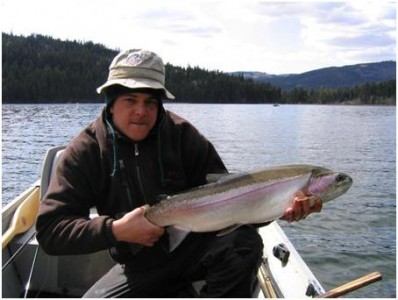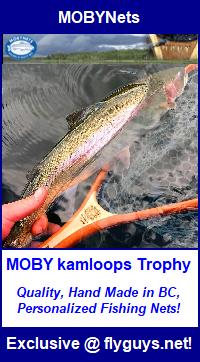This is an exceptional article on deep water chironomid fishing witten by By Jason Majoskey (AKA Mr Rainbow). It was edited by Al Horne (horneblower) & Illustrated by Dale Sharp (Sharpy). It’s a fairly long read but well worth your while to go through it all – it will improve your fishing! Thanks guys for sharing this valuable information and allowing us to post it on our site! 😀
Fly Fishing Chironomids
– Long Lining Deep Water Chironomids –
Over the years I have tried just about every stillwater technique I have ever read or heard about. The method which has become my favourite, and which I now find most productive, is long-lining deep water chironomids, also known as fishing “naked.” It is similar to the “standard” strike-indicator method, except that it uses no indicators. It involves only a floating line, long leader and a weighted fly.
At first I was very hesitant to try this method of fly fishing chironomids. I was intimidated by the thought of trying to cast the long leaders, and skeptical about being able to detect strikes without the presence of an indicator. One day, however, during a spell of frustrating fishing, I finally decided to give the method a try. To my surprise, I caught three fish on the first three casts. I was amazed at how well the method enabled me to detect strikes and light takes. So was my fishing partner Adam, who was anchored nearby. From that day on we were hooked, and over the next several seasons we spent many days on the water honing our skills. If you’re like I was, reluctant to try this technique, I hope this article will get you through the basics and into long-lining deep water chironomids.
Deep water chironomid (ing), Long-lining, is practical for fishing depths of up to 30 feet, and yes, that can mean long leaders. The length of leader used depends on the depth you are fishing. The majority of the time fly fishing chironomids is done with the fly one foot or less from the bottom. So, to put your fly in the “zone,” take the depth of the water and add 25% to it in order to come up with the correct length of leader. For example, if you’re in 20 feet of water, you will want a leader with a total length of 25 feet. The extra length is necessary because your leader does not go down straight from the end of your fly line; instead, it drops in a gradual arc with only the last part hanging vertically. The extra 25% of line compensates for this arc, and puts your fly in “the zone”, close to the bottom. Additionally, surface currents caused by strong winds can create even longer arcs in the leader, so a little more than 25% is required on windy days.
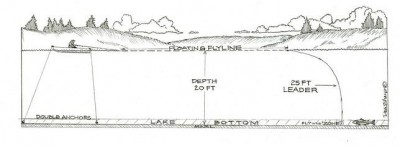 I like chironomid patterns tied with tungsten beads to help get the fly down quickly. I do not favour the use of external weights like split shot, because too much weight can sink the end of your floating line and put your fly into the mud, rather than just above it.
I like chironomid patterns tied with tungsten beads to help get the fly down quickly. I do not favour the use of external weights like split shot, because too much weight can sink the end of your floating line and put your fly into the mud, rather than just above it.
You will have to wait two or three minutes after your cast to allow the fly time to sink to the desired depth. Once you are confident the fly is fully sunk, start a very slow retrieve. The purpose of the retrieve is to stay in contact with the fly. If your retrieve is too fast you will lift the fly out of “the zone.” Hand-twist retrieves work well, but rather than using the usual four fingers, use only the first two, to help keep the retrieve slow. Another option is to use micro-strips-tiny little strips that pull in only one-half inch of fly line at a time. Try to keep a loose grip on the fly line in case you get a violent strike. Also, while you’re retrieving, it is very important to keep the rod tip on the surface of the water. If your tip is off the water, your fly line will hang down and create slack line. All slack line is to be avoided, because it reduces your ability to detect strikes and hook fish.
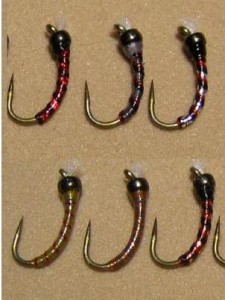 Strikes can vary from violent smashes to subtle takes. The violent ones are obvious, but the subtle ones will feel like a light bump, or just a slight resistance in your retrieve. If it’s a calm day you should also watch the tip of your line for hits. The tip may move in an unusual manner, or start to go under water. You should, however, be able to feel the take at the same time, providing you are doing everything right, and there is no slack in your line. Once I feel a strike, I like to lift the rod and pull down on the fly line at the same time. The key here is to learn restraint: stop the strike as soon as you make contact with the fish. This will usually prevent break-offs.
Strikes can vary from violent smashes to subtle takes. The violent ones are obvious, but the subtle ones will feel like a light bump, or just a slight resistance in your retrieve. If it’s a calm day you should also watch the tip of your line for hits. The tip may move in an unusual manner, or start to go under water. You should, however, be able to feel the take at the same time, providing you are doing everything right, and there is no slack in your line. Once I feel a strike, I like to lift the rod and pull down on the fly line at the same time. The key here is to learn restraint: stop the strike as soon as you make contact with the fish. This will usually prevent break-offs.
The most important piece of equipment for fly fishing chironomids with this technique is a good floating line-one which floats well and has virtually no memory. Any memory in the line will cause “squiggles”; “squiggles” mean slack, and slack means a loss of sensitivity to strikes, which, again, means fewer fish.
When it comes to leaders, different people have their own definite preferences. Some just use straight mono with some tippet added at the end, while others use elaborate tapered leaders. Because they turn over, I prefer tapered leaders, but I keep them pretty simple.
To start with, I use a standard tapered trout leader, but I cut off the first few feet of it–the thinnest part of the leader– until it is similar in diameter to the next section I will add, which is 8 pound test Maxima Ultragreen. The Maxima is very thick, so adding 7-15 feet of it will help turn the leader over. After the Maxima I will tie in a section of 6 pound Berkely Vanish. Finally, I will finish the leader with 4-5 feet of high-quality fluorocarbon tippet. The amount of Maxima and Vanish used will depend on the total length of leader you are building: the longer the leader, the more you add of these two sections. I recommend that you adjust the length of your leaders by adding or removing line from the Vanish section, and avoid adjusting the length of your tippet, since it is the most expensive section of the entire leader.
If you use a loop connection between your fly line and leader, you can re-use these leaders over and over. When you are done long-lining, just remove the entire leader and store it on an old tippet spool. Now you can put your standard leader on and fish another method; meanwhile, your long-line leader is there, ready to go for next time.
 Now that you have your long leader tied, you have to cast it. This is the biggest stumbling block for most anglers, and the main reason they hesitate in trying this type of fishing. The tricky part is getting the cast started: once you have your leader in the air, it’s not that difficult to cast.
Now that you have your long leader tied, you have to cast it. This is the biggest stumbling block for most anglers, and the main reason they hesitate in trying this type of fishing. The tricky part is getting the cast started: once you have your leader in the air, it’s not that difficult to cast.
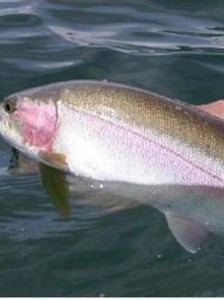 So, the first and hardest part will be getting your leader out of the water, because when you come to the end of your retrieve, your weighted fly will be at depths of up to 30 feet. You can not just lift this entire leader up and out of the water; and even if you could, trying to cast such a long leader with only a few feet of fly line out is a recipe for a large, tangled mess of line. What you need for a successful cast is as much fly line out as leader. To accomplish this, and also to bring the fly to the surface, I use a series of roll casts. Each roll cast brings the fly higher and higher, and at the same time gets out more fly line. The number of roll casts required depends on the length of leader and how powerful the roll casts are. It normally takes me about three roll casts to lift a fly from the water, get enough fly line out to cast with, and have line and leader lying straight out on the water in front of me.
So, the first and hardest part will be getting your leader out of the water, because when you come to the end of your retrieve, your weighted fly will be at depths of up to 30 feet. You can not just lift this entire leader up and out of the water; and even if you could, trying to cast such a long leader with only a few feet of fly line out is a recipe for a large, tangled mess of line. What you need for a successful cast is as much fly line out as leader. To accomplish this, and also to bring the fly to the surface, I use a series of roll casts. Each roll cast brings the fly higher and higher, and at the same time gets out more fly line. The number of roll casts required depends on the length of leader and how powerful the roll casts are. It normally takes me about three roll casts to lift a fly from the water, get enough fly line out to cast with, and have line and leader lying straight out on the water in front of me.
Now that you’ve accomplished that, and before the fly has a chance to sink, immediately start false casting. Two false casts are usually enough; (more just increase your chances of tangles and wind knots.) You will never turn these really long leaders over completely, but at least the majority of the leader will turn over, (which again, is why I prefer tapered leaders.) Occasionally, a fish will take while the fly is sinking, and if your leader has turned over you will have a good chance of detecting the strike. On the other hand, if your leader has hit the water in a big pile, you will have created slack, lost contact with the fly, and will likely not hook up with these fish. Finally, always cast directly downwind: it will help keep your line straight and free of slack. Position your boat so that you can cast downwind and sit comfortably, with your rod tip on the water, pointed at your line.
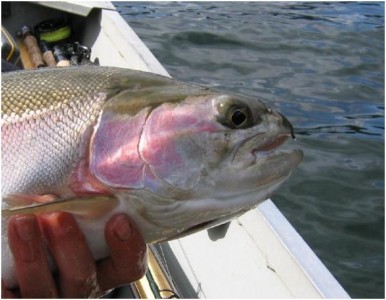 There are a number of reasons I prefer the long lining deep water chironomids method over indicator fishing. First, casting without an indicator is much easier and less prone to tangles. Also, fly fishing chironomids with an indicator requires your eyes be fixed on the indicator to avoid missing takes; whereas the long-line deep water chironomid system is a little more “hands-on” and makes you feel more involved than just staring at an indicator. I still use indicators for fishing the shallower water because it’s easier to make quick depth changes, but I use the “naked” method for depths of 15-30 feet. Many anglers like to fish two rods at once, but when I am using the long-line method I prefer to focus all my attention on that one rod. Still, I will often rig up two rods, one with the long line and one equipped with an indicator, so I am ready to cover all the depths. If you want to fish two rods at once, I suggest you use an indicator on your second rod so that you can secure it in a rod holder and visually monitor it, while you work the retrieve mainly by feel on the long-line rod.
There are a number of reasons I prefer the long lining deep water chironomids method over indicator fishing. First, casting without an indicator is much easier and less prone to tangles. Also, fly fishing chironomids with an indicator requires your eyes be fixed on the indicator to avoid missing takes; whereas the long-line deep water chironomid system is a little more “hands-on” and makes you feel more involved than just staring at an indicator. I still use indicators for fishing the shallower water because it’s easier to make quick depth changes, but I use the “naked” method for depths of 15-30 feet. Many anglers like to fish two rods at once, but when I am using the long-line method I prefer to focus all my attention on that one rod. Still, I will often rig up two rods, one with the long line and one equipped with an indicator, so I am ready to cover all the depths. If you want to fish two rods at once, I suggest you use an indicator on your second rod so that you can secure it in a rod holder and visually monitor it, while you work the retrieve mainly by feel on the long-line rod.
Next time you’re fly fishing chironomids, give the long-line deep water chironomid method a try; I hope you’ll come to enjoy it as much as I do. 😀
*** for more still water fly fishing strategies please hit up & review our still water fly fishing category here!
Like our stuff? Subscribe by ![]() Feed or
Feed or ![]() Email
Email .jpg)

